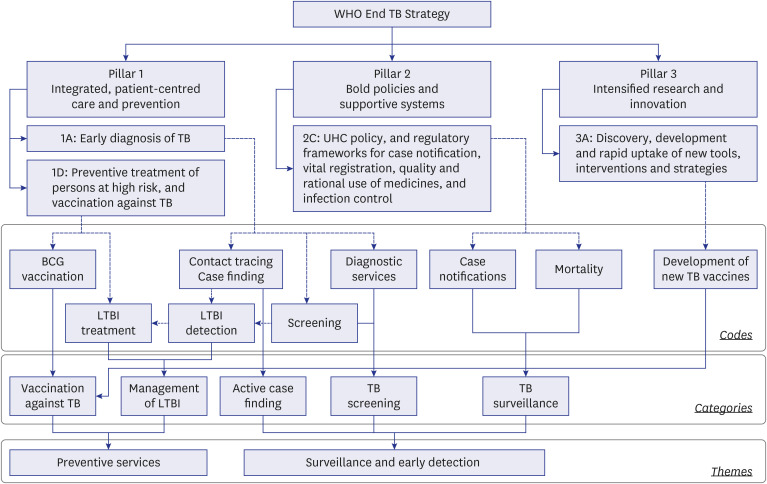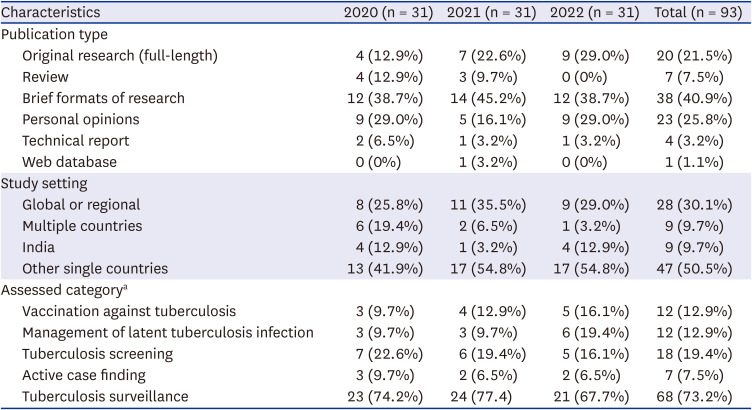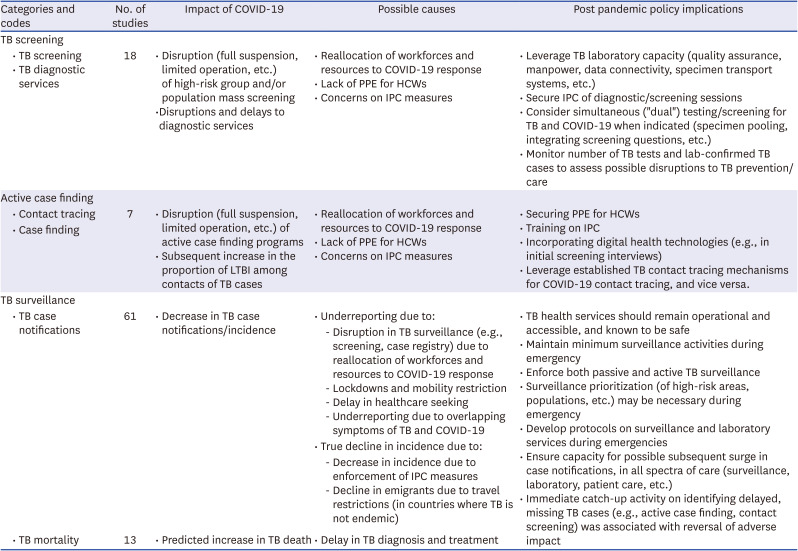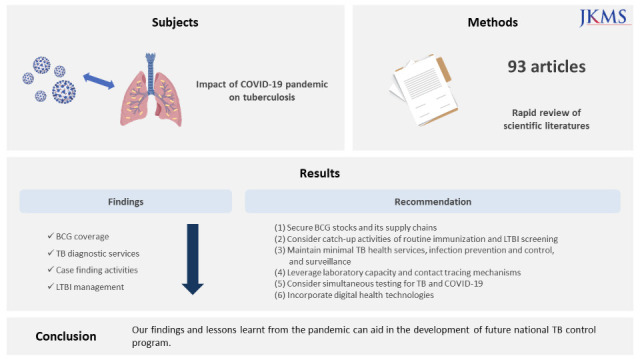1. COVID-19 Excess Mortality Collaborators. Estimating excess mortality due to the COVID-19 pandemic: a systematic analysis of COVID-19-related mortality, 2020-21. Lancet. 2022; 399(10334):1513–1536. PMID:
35279232.
2. World Health Organization. Global Tuberculosis Report 2021. Geneva, Switzerland: World Health Organization;2021.
3. Houben RM, Dodd PJ. The global burden of latent tuberculosis infection: a re-estimation using mathematical modelling. PLoS Med. 2016; 13(10):e1002152. PMID:
27780211.
4. World Health Organization. Implementing the End TB Strategy: The Essentials. Geneva, Switzerland: World Health Organization;2015.
5. Pai M, Kasaeva T, Swaminathan S. Covid-19's Devastating Effect on Tuberculosis Care - A Path to Recovery. N Engl J Med. 2022; 386(16):1490–1493. PMID:
34986295.
6. Page MJ, McKenzie JE, Bossuyt PM, Boutron I, Hoffmann TC, Mulrow CD, et al. The PRISMA 2020 statement: an updated guideline for reporting systematic reviews. BMJ. 2021; 372:n71. PMID:
33782057.
7. Booth A. Clear and present questions: formulating questions for evidence based practice. Libr Hi Tech. 2006; 24(3):355–368.
8. McGowan J, Sampson M, Salzwedel DM, Cogo E, Foerster V, Lefebvre C. PRESS peer review of electronic search strategies: 2015 guideline statement. J Clin Epidemiol. 2016; 75:40–46. PMID:
27005575.
10. Maltezou HC, Medic S, Cassimos DC, Effraimidou E, Poland GA. Decreasing routine vaccination rates in children in the COVID-19 era. Vaccine. 2022; 40(18):2525–2527. PMID:
35341648.
11. Chandir S, Siddiqi DA, Mehmood M, Setayesh H, Siddique M, Mirza A, et al. Impact of COVID-19 pandemic response on uptake of routine immunizations in Sindh, Pakistan: an analysis of provincial electronic immunization registry data. Vaccine. 2020; 38(45):7146–7155. PMID:
32943265.
12. McQuaid CF, Vassall A, Cohen T, Fiekert K, White RG. COVID/TB Modelling Working Group. The impact of COVID-19 on TB: a review of the data. Int J Tuberc Lung Dis. 2021; 25(6):436–446. PMID:
34049605.
13. Barcat JA, Kantor IN, Ritacco V. One hundred years of BCG vaccine. Medicina (B Aires). 2021; 81(6):1007–1014. PMID:
34875601.
14. Golandaj JA. Pediatric TB detection in the era of COVID-19. Indian J Tuberc. 2022; 69(1):104–108. PMID:
35074141.
15. Shaikh N, Pelzer PT, Thysen SM, Roy P, Harris RC, White RG. Impact of COVID-19 disruptions on global BCG coverage and paediatric TB mortality: a modelling study. Vaccines (Basel). 2021; 9(11):1228. PMID:
34835161.
16. Senoo Y, Suzuki Y, Takahashi K, Tsuda K, Tanimoto T. Prioritizing infants in a time of Bacille Calmette-Guérin vaccine shortage caused by premature expectations against COVID-19. QJM. 2020; 113(10):773–774. PMID:
32442278.
17. Namkoong H, Horita N, Ebina-Shibuya R. Concern over a COVID-19-related BCG shortage. Int J Tuberc Lung Dis. 2020; 24(6):642–643. PMID:
32552997.
18. Dockrell HM, McShane H. Tuberculosis vaccines in the era of Covid-19 - what is taking us so long? EBioMedicine. 2022; 79:103993. PMID:
35427852.
19. Rangaka MX, Hamada Y, Abubakar I. Ending the tuberculosis syndemic: is COVID-19 the (in)convenient scapegoat for poor progress? Lancet Respir Med. 2022; 10(6):529–531. PMID:
35338839.
20. Loh FK, Thong PM, Ong CW. The crucial need for tuberculosis translational research in the time of COVID-19. Lancet Respir Med. 2022; 10(6):531–533. PMID:
35338842.
21. Migliori GB, Thong PM, Akkerman O, Alffenaar JW, Álvarez-Navascués F, Assao-Neino MM, et al. Worldwide effects of coronavirus disease pandemic on tuberculosis services, January-April 2020. Emerg Infect Dis. 2020; 26(11):2709–2712. PMID:
32917293.
22. Migliori GB, Thong PM, Alffenaar JW, Denholm J, Tadolini M, Alyaquobi F, et al. Country-specific lockdown measures in response to the COVID-19 pandemic and its impact on tuberculosis control: a global study. J Bras Pneumol. 2022; 48(2):e20220087. PMID:
35475873.
23. Bagcchi S. Dismal global tuberculosis situation due to COVID-19. Lancet Infect Dis. 2021; 21(12):1636. PMID:
34838229.
24. Yadav P, Vohra C, Gopalakrishnan M, Garg MK. Integrating health planning and primary care infrastructure for COVID-19 and tuberculosis care in India: challenges and opportunities. Int J Health Plann Manage. 2022; 37(2):632–642. PMID:
34820907.
25. Geric C, Saroufim M, Landsman D, Richard J, Benedetti A, Batt J, et al. Impact of COVID-19 on tuberculosis prevention and treatment in Canada: a multicenter analysis of 10 833 patients. J Infect Dis. 2022; 225(8):1317–1320. PMID:
34919700.
26. Rodrigues I, Aguiar A, Migliori GB, Duarte R. Impact of the COVID-19 pandemic on tuberculosis services. Pulmonology. 2022; 28(3):210–219. PMID:
35219624.
27. Godoy P, Parrón I, Barrabeig I, Caylà JA, Clotet L, Follia N, et al. Impact of the COVID-19 pandemic on contact tracing of patients with pulmonary tuberculosis. Eur J Public Health. 2022; 32(4):643–647. PMID:
35325093.
28. Gigante AR, Sousa M, Aguiar A, Pinto M, Gaio R, Duarte R. The impact of COVID-19 on the TB response: data from the field. Int J Tuberc Lung Dis. 2021; 25(9):769–771. PMID:
34802502.
29. Aznar ML, Espinosa-Pereiro J, Saborit N, Jové N, Sánchez Martinez F, Pérez-Recio S, et al. Impact of the COVID-19 pandemic on tuberculosis management in Spain. Int J Infect Dis. 2021; 108:300–305. PMID:
33930543.
30. Bhatia V, Mandal PP, Satyanarayana S, Aditama TY, Sharma M. Mitigating the impact of the COVID-19 pandemic on progress towards ending tuberculosis in the WHO South-East Asia Region. WHO South-East Asia J Public Health. 2020; 9(2):95–99. PMID:
32978339.
31. Loveday M, Cox H, Evans D, Furin J, Ndjeka N, Osman M, et al. Opportunities from a new disease for an old threat: extending COVID-19 efforts to address tuberculosis in South Africa. S Afr Med J. 2020; 110(12):1160–1167. PMID:
33403958.
32. Schiza V, Kruse M, Xiao Y, Kar S, Lovejoy K, Wrighton-Smith P, et al. Impact of the COVID-19 pandemic on TB infection testing. Int J Tuberc Lung Dis. 2022; 26(2):174–176. PMID:
35086632.
33. Dean AS, Tosas Auguet O, Glaziou P, Zignol M, Ismail N, Kasaeva T, et al. 25 years of surveillance of drug-resistant tuberculosis: achievements, challenges, and way forward. Lancet Infect Dis. 2022; 22(7):e191–e196. PMID:
35248168.
34. Togun T, Kampmann B, Stoker NG, Lipman M. Anticipating the impact of the COVID-19 pandemic on TB patients and TB control programmes. Ann Clin Microbiol Antimicrob. 2020; 19(1):21. PMID:
32446305.
35. Umubyeyi Nyaruhirira A, Scholten JN, Gidado M, Suarez PG. Coronavirus disease 2019 diagnosis in low- and middle-income countries: the big new bully disrupting TB and HIV diagnostic services. J Mol Diagn. 2022; 24(4):289–293. PMID:
35123038.
36. Velavan TP, Meyer CG, Esen M, Kremsner PG, Ntoumi F. PANDORA-ID-NET and CANTAM Consortium. COVID-19 and syndemic challenges in ‘Battling the Big Three’: HIV, TB and malaria. Int J Infect Dis. 2021; 106:29–32. PMID:
33781904.
37. Homolka S, Paulowski L, Andres S, Hillemann D, Jou R, Günther G, et al. Two pandemics, one challenge-leveraging molecular test capacity of tuberculosis laboratories for rapid COVID-19 case-finding. Emerg Infect Dis. 2020; 26(11):2549–2554. PMID:
32956612.
38. Nikolayevskyy V, Holicka Y, van Soolingen D, van der Werf MJ, Ködmön C, Surkova E, et al. Impact of the COVID-19 pandemic on tuberculosis laboratory services in Europe. Eur Respir J. 2021; 57(1):2003890. PMID:
33184119.
39. Rakotosamimanana N, Randrianirina F, Randremanana R, Raherison MS, Rasolofo V, Solofomalala GD, et al. GeneXpert for the diagnosis of COVID-19 in LMICs. Lancet Glob Health. 2020; 8(12):e1457–e1458. PMID:
33091372.
40. Kumar P, Goyal JP. Tuberculosis during Covid-19 pandemic: challenges and opportunities. Indian Pediatr. 2020; 57(11):1082.
41. Min J, Kim HW, Koo HK, Ko Y, Oh JY, Kim J, et al. Impact of COVID-19 pandemic on the national PPM tuberculosis control project in Korea: the Korean PPM monitoring database between July 2019 and June 2020. J Korean Med Sci. 2020; 35(43):e388. PMID:
33169559.
42. Chan G, Triasih R, Nababan B, du Cros P, Wilks N, Main S, et al. Adapting active case-finding for TB during the COVID-19 pandemic in Yogyakarta, Indonesia. Public Health Action. 2021; 11(2):41–49. PMID:
34159059.
43. Saini V, Garg K. Case finding strategies under National Tuberculosis Elimination Programme (NTEP). Indian J Tuberc. 2020; 67(4S):S101–S106. PMID:
33308653.
44. Fei H, Yinyin X, Hui C, Ni W, Xin D, Wei C, et al. The impact of the COVID-19 epidemic on tuberculosis control in China. Lancet Reg Health West Pac. 2020; 3:100032. PMID:
34173601.
45. Arsenault C, Gage A, Kim MK, Kapoor NR, Akweongo P, Amponsah F, et al. COVID-19 and resilience of healthcare systems in ten countries. Nat Med. 2022; 28(6):1314–1324. PMID:
35288697.
46. Arentz M, Ma J, Zheng P, Vos T, Murray CJ, Kyu HH. The impact of the COVID-19 pandemic and associated suppression measures on the burden of tuberculosis in India. BMC Infect Dis. 2022; 22(1):92. PMID:
35086472.
47. Chiang CY, Islam T, Xu C, Chinnayah T, Garfin AM, Rahevar K, et al. The impact of COVID-19 and the restoration of tuberculosis services in the Western Pacific Region. Eur Respir J. 2020; 56(4):2003054. PMID:
32978310.
48. Fatima R, Akhtar N, Yaqoob A, Harries AD, Khan MS. Building better tuberculosis control systems in a post-COVID world: learning from Pakistan during the COVID-19 pandemic. Int J Infect Dis. 2021; 113(Suppl 1):S88–S90. PMID:
33744479.
49. Liu Q, Lu P, Shen Y, Li C, Wang J, Zhu L, et al. Collateral impact of the coronavirus disease 2019 (COVID-19) pandemic on tuberculosis control in Jiangsu Province, China. Clin Infect Dis. 2021; 73(3):542–544. PMID:
32857838.
50. Adewole OO. Impact of COVID-19 on TB care: experiences of a treatment centre in Nigeria. Int J Tuberc Lung Dis. 2020; 24(9):981–982. PMID:
33156771.
51. de Souza CD, Coutinho HS, Costa MM, Magalhães MA, Carmo RF. Impact of COVID-19 on TB diagnosis in Northeastern Brazil. Int J Tuberc Lung Dis. 2020; 24(11):1220–1222. PMID:
33172534.
52. Kwak N, Hwang SS, Yim JJ. Effect of COVID-19 on tuberculosis notification, South Korea. Emerg Infect Dis. 2020; 26(10):2506–2508. PMID:
32672531.
53. Beyene NW, Sitotaw AL, Tegegn B, Bobosha K. The impact of COVID-19 on the tuberculosis control activities in Addis Ababa. Pan Afr Med J. 2021; 38:243. PMID:
34104291.
54. Komiya K, Yamasue M, Takahashi O, Hiramatsu K, Kadota JI, Kato S. The COVID-19 pandemic and the true incidence of tuberculosis in Japan. J Infect. 2020; 81(3):e24–e25.
55. Behera D. Tuberculosis, COVID-19, and the end tuberculosis strategy in India. Lung India. 2020; 37(6):467–472. PMID:
33154206.
56. Bhargava A, Shewade HD. The potential impact of the COVID-19 response related lockdown on TB incidence and mortality in India. Indian J Tuberc. 2020; 67(4S):S139–S146. PMID:
33308660.
57. Wu Z, Chen J, Xia Z, Pan Q, Yuan Z, Zhang W, et al. Impact of the COVID-19 pandemic on the detection of TB in Shanghai, China. Int J Tuberc Lung Dis. 2020; 24(10):1122–1124. PMID:
33126952.
58. Kadota JL, Reza TF, Nalugwa T, Kityamuwesi A, Nanyunja G, Kiwanuka N, et al. Impact of shelter-in-place on TB case notifications and mortality during the COVID-19 pandemic. Int J Tuberc Lung Dis. 2020; 24(11):1212–1214. PMID:
33172531.
59. Lebina L, Dube M, Hlongwane K, Brahmbatt H, Lala SG, Reubenson G, et al. Trends in paediatric tuberculosis diagnoses in two South African hospitals early in the COVID-19 pandemic. S Afr Med J. 2020; 110(12):1149–1150. PMID:
33403952.
60. Lungu PS, Kerkhoff AD, Muyoyeta M, Kasapo CC, Nyangu S, Kagujje M, et al. Interrupted time-series analysis of active case-finding for tuberculosis during the COVID-19 pandemic, Zambia. Bull World Health Organ. 2022; 100(3):205–215. PMID:
35261409.
61. Filardo TD, Feng PJ, Pratt RH, Price SF, Self JL. Tuberculosis - United States, 2021. MMWR Morb Mortal Wkly Rep. 2022; 71(12):441–446. PMID:
35324877.
62. Ullrich A, Schranz M, Rexroth U, Hamouda O, Schaade L, Diercke M, et al. Impact of the COVID-19 pandemic and associated non-pharmaceutical interventions on other notifiable infectious diseases in Germany: An analysis of national surveillance data during week 1-2016 - week 32-2020. Lancet Reg Health Eur. 2021; 6:100103. PMID:
34557831.
63. Hasan T, Nguyen VN, Nguyen HB, Nguyen TA, Le HT, Pham CD, et al. Retrospective cohort study of effects of the COVID-19 pandemic on tuberculosis notifications, Vietnam, 2020. Emerg Infect Dis. 2022; 28(3):684–692. PMID:
35202526.
64. Tok PS, Kamarudin NA, Jamaludin M, Ab Razak MF, Ahmad MA, Abu Bakar FA, et al. Effect of COVID-19 on tuberculosis notification in Johor Bahru, Malaysia. Infect Dis (Lond). 2022; 54(3):235–237. PMID:
34772327.
65. Lewer D, Mulchandani R, Roche A, Cosgrove C, Anderson C. Why has the incidence of tuberculosis not reduced in London during the COVID-19 pandemic? Lancet Respir Med. 2022; 10(3):231–233. PMID:
35032431.
66. Glaziou P. Predicted impact of the COVID-19 pandemic on global tuberculosis deaths in 2020. medRxiv. October. 8. 2020; DOI:
10.1101/2020.04.28.20079582.
67. McQuaid CF, McCreesh N, Read JM, Sumner T, Houben RMGJ, et al. CMMID COVID-19 Working Group. The potential impact of COVID-19-related disruption on tuberculosis burden. Eur Respir J. 2020; 56(2):2001718. PMID:
32513784.
68. Cilloni L, Fu H, Vesga JF, Dowdy D, Pretorius C, Ahmedov S, et al. The potential impact of the COVID-19 pandemic on the tuberculosis epidemic a modelling analysis. EClinicalMedicine. 2020; 28:100603. PMID:
33134905.
69. Delamou A, Ayadi AM, Sidibe S, Delvaux T, Camara BS, Sandouno SD, et al. Effect of Ebola virus disease on maternal and child health services in Guinea: a retrospective observational cohort study. Lancet Glob Health. 2017; 5(4):e448–e457. PMID:
28237252.
70. Camara BS, Delamou AM, Diro E, El Ayadi A, Béavogui AH, Sidibé S, et al. Influence of the 2014-2015 Ebola outbreak on the vaccination of children in a rural district of Guinea. Public Health Action. 2017; 7(2):161–167. PMID:
28695091.
71. Jirjees FJ, Dallal Bashi YH, Al-Obaidi HJ. COVID-19 death and BCG vaccination programs worldwide. Tuberc Respir Dis (Seoul). 2021; 84(1):13–21. PMID:
32883062.
72. Bok K, Sitar S, Graham BS, Mascola JR. Accelerated COVID-19 vaccine development: milestones, lessons, and prospects. Immunity. 2021; 54(8):1636–1651. PMID:
34348117.
73. Marx FM, Hauer B, Menzies NA, Haas W, Perumal N. Targeting screening and treatment for latent tuberculosis infection towards asylum seekers from high-incidence countries - a model-based cost-effectiveness analysis. BMC Public Health. 2021; 21(1):2172. PMID:
34836526.
74. The Global Fund. Briefing Note on Testing for Both Tuberculosis and SARS-CoV-2. Geneva, Switzerland: The Global Fund;2021.
77. World Health Organization. Impact of the COVID-19 Pandemic on TB Detection and Mortality in 2020. Geneva, Switzerland: World Health Organization;2021.
78. Stop TB Partnership. The Potential Impact of the COVID-19 Response on Tuberculosis in High-Burden Countries: A Modelling Analysis. Geneva, Switzerland: Stop TB Partnership;2020.
79. Teo AK, Ong CW, Hsu LY. COVID-19 and TB: a progression-regression conundrum. Int J Tuberc Lung Dis. 2021; 25(6):421–423. PMID:
34049602.
80. Khan FM, Kazmi Z, Hasan MM, Dos Santos Costa AC, Ahmad S, Essar MY. Resurgence of tuberculosis amid COVID-19 in Peru: associated risk factors and recommendations. Int J Health Plann Manage. 2021; 36(6):2441–2445. PMID:
34318523.
81. Chen H, Zhang K. Insight into the impact of the COVID-19 epidemic on tuberculosis burden in China. Eur Respir J. 2020; 56(3):2002710. PMID:
32703778.
82. Zamani S, Honarvar MR, Behnampour N, Sheikhy M, Sedaghat M, Ghaemi S, et al. Decline in TB incidence during the COVID-19 pandemic. Int J Tuberc Lung Dis. 2021; 25(12):1043–1044. PMID:
34886939.
83. Coronel Teixeira R, Aguirre S, Pérez Bejarano D. Thinking about tuberculosis in times of COVID-19. J Intern Med. 2021; 289(4):589–590. PMID:
33078450.
84. Fukunaga R, Glaziou P, Harris JB, Date A, Floyd K, Kasaeva T. Epidemiology of tuberculosis and progress toward meeting global targets - worldwide, 2019. MMWR Morb Mortal Wkly Rep. 2021; 70(12):427–430. PMID:
33764960.
85. Maia CMF, Martelli DRB, Silveira DMMLD, Oliveira EA, Martelli Júnior H. Tuberculosis in Brazil: the impact of the COVID-19 pandemic. J Bras Pneumol. 2022; 48(2):e20220082. PMID:
35475872.
86. Ortiz-Martínez Y, Rodríguez-Morales AJ, Henao-Martínez AF. Decreased notification of TB cases during the COVID-19 pandemic. Int J Tuberc Lung Dis. 2022; 26(2):177–178. PMID:
35086633.
87. Cardenas-Escalante J, Fernandez-Saucedo J, Cubas WS. Impact of the COVID-19 pandemic on tuberculosis in Peru: are we forgetting anyone? Enferm Infecc Microbiol Clin. 2022; 40(1):46–47. PMID:
34456408.
88. Choi H, Ko Y, Lee CY, Chung SJ, Kim HI, Kim JH, et al. Impact of COVID-19 on TB epidemiology in South Korea. Int J Tuberc Lung Dis. 2021; 25(10):854–860. PMID:
34615583.
89. Dadras O, Alinaghi SA, Karimi A, MohsseniPour M, Barzegary A, Vahedi F, et al. Effects of COVID-19 prevention procedures on other common infections: a systematic review. Eur J Med Res. 2021; 26(1):67. PMID:
34217366.








 PDF
PDF Citation
Citation Print
Print





 XML Download
XML Download